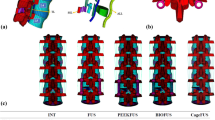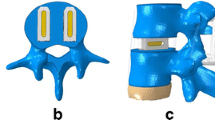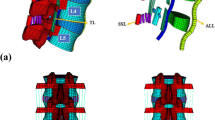Abstract
An interspinous fusion system (IFS) has been introduced as an alternative to pedicle screw fixation (PSF), commonly used in spinal fusion. In this study, a finite element analysis was performed to assess biomechanical efficacy of the combined IFS with an interbody fusion cage. post-operative models were created to compare the biomechanical efficacy of IFS to that of other fixations including: Type 1, Fusion cage only; Type 2, IFS only; Type 3, PSF only; Type 4, Type 1 plus Type 2; Type 5, Type 1 plus Type 3. All device implantations were simulated at L4-5. At the operated level, Type 4 was shown to have comparable reduction in ROM (range of motion) as Type 5 with both models effectively inducing greater stability compared to other models regardless of loading type. At the adjacent level, Type 4 showed less increase in ROM than Type 5 and was closer to the pre-operative level. In terms of the COR (center of rotation) and load sharing between the anterior and posterior parts of the spine, Type 4 remained closer to that of the intact spine. These results suggest that IFS with a cage may help reduce degeneration at adjacent levels while effectively providing stability at the operated level.
Similar content being viewed by others
References
Hilibrand, A. S. and Rand, N., “Degenerative Lumbar Stenosis: Diagnosis and Management,” Journal of the American Academy of Orthopaedic Surgeons, Vol. 7, No. 4, pp. 239–249, 1999.
Oda, I., Cunningham, B. W., Lee, G. A., Abumi, K., Kaneda, K., and McAfee, P. C., “Biomechanical Properties of Anterior Thoracolumbar Multisegmental Fixation: An Analysis of Construct Stiffness and Screw-Rod Strain,” Spine, Vol. 25, No. 18, pp. 2303–2311, 2000.
Akamaru, T., Kawahara, N., Yoon, S. T., Minamide, A., Kim, K. S., et al., “Adjacent Segment Motion after a Simulated Lumbar Fusion in Different Sagittal Alignments: A Biomechanical Analysis,” Spine, Vol. 28, No. 14, pp. 1560–1566, 2003.
Chow, D. H., Luk, K. D., Evans, J. H., and Leong, J. C., “Effects of Short Anterior Lumbar Interbody Fusion on Biomechanics of Neighboring Unfused Segments,” Spine, Vol. 21, No. 5, pp. 549–555, 1996.
Steffee, A. D. and Sitkowski, D. J., “Posterior lumbar Interbody Fusion and Plates,” Clinical Orthopaedics and Related Research, Vol. 227, pp. 99–102, 1988.
Voronov, L. I., Tsitsopoulos, P. P., Havey, R. M., Potluri, T., et al., “Biomechanical Assessment of a Polyaxial Interspinous Plating System as an Adjunct to Interbody Fusion,” Proc. of Orthopaedic Research Society Annual Meeting, Poster No. 2146, 2012.
Karahalios, D Anchor. G., Kaibara, T., Porter, R. W., Kakarla, U. K., Reyes, P. M., et al., “Biomechanics of a Lumbar Interspinous with Anterior Lumbar Interbody Fusion: Laboratory Investigation,” Journal of Neurosurgery: Spine, Vol. 12, No. 4, pp. 372–380, 2010.
Chen, W. M., Park, C., Lee, K., and Lee, S., “In Situ Contact Analysis of the Prosthesis Components of Prodisc-L in Lumbar Spine Following Total Disc Replacement,” Spine, Vol. 34, No. 20, pp. E716–E723, 2009.
Ahn, Y. H., Jung, D. Y., Park, K. W., and Lee, S. J., “Biomechanical Effects of Posterior Dynamic Stabilization System on Lumbar Kinematics: A Finite Element Analysis,” Journal of Biomedical Engineering Research, Vol. 29, No. 2, pp. 139–145, 2008.
Zander, T., Rohlmann, A., Calisse, J., and Bergmann, G., “Estimation of Muscle Forces in the Lumbar Spine during Upper-Body Inclination,” Clinical Biomechanics, Vol. 16, pp. S73–S80, 2001.
Goel, V. K., Monroe, B. T., Gilbertson, L. G., and Brinckmann, P., “Interlaminar Shear Stresses and Laminae Separation in a Disc: Finite Element Analysis of the L3–L4 Motion Segment Subjected to Axial Compressive Loads,” Spine, Vol. 20, No. 6, pp. 689–698, 1995.
Shirazi-Adl, S. A., Shrivastava, S. C., and Ahmed, A. M., “Stress Analysis of the Lumbar Disc-Body Unit in Compression a Three- Dimensional Nonlinear Finite Element Study,” Spine, Vol. 9, No. 2, pp. 120–134, 1984.
Sharma, M., Langrana, N. A., and Rodriguez, J., “Role of Ligaments and Facets in Lumbar Spinal Stability,” Spine, Vol. 20, No. 8, pp. 887–900, 1995.
Smit, T. H., Odgaard, A., and Schneider, E., “Structure and Function of Vertebral Trabecular Bone,” Spine, Vol. 22, No. 24, pp. 2823–2833, 1997.
Panjabi, M. M. and Goel, V. K., “Adjacent-Level Effects: Design of a New Test Protocol and Finite Element Model Simulations of Disc Replacement,” Roundtables in Spine Surgery; Spine Biomechanics: Evaluation of Motion Preservation Devices and Relevant Terminology, Vol. 1, No. 1, pp. 45–58, 2005.
Kettler, A., Drumm, J., Heuer, F., Haeussler, K., Mack, C., et al., “Can a Modified Interspinous Spacer Prevent Instability in Axial Rotation and Lateral Bending? A Biomechanical in Vitro Study Resulting in a New Idea,” Clinical Biomechanics, Vol. 23, No. 2, pp. 242–247, 2008.
Pollintine, P., Dolan, P., Tobias, J. H., and Adams, M. A., “Intervertebral Disc Degeneration Can Lead to “Stress-Shielding” of the Anterior Vertebral Body: A Cause of Osteoporotic Vertebral Fracture?” Spine, Vol. 29, No. 7, pp. 774–782, 2004.
Gertzbein, S., Chan, K., Tile, M., Seligman, J., and Kapasouri, A., “Moire Patterns: An Accurate Technique for Determination of the Locus of the Centres of Rotation,” Journal of Biomechanics, Vol. 18, No. 7, pp. 501–509, 1985.
Brodke, D. S., Gollogly, S., Bachus, K. N., Mohr, R. A., and Nguyen, B. K. N., “Anterior Thoracolumbar Instrumentation: Stiffness and Load Sharing Characteristics of Plate and Rod Systems,” Spine, Vol. 28, No. 16, pp. 1794–1801, 2003.
Moumene, M. and Afshari, P., “Biomechanical Comparison of Rigid vs. Semi-rigid Rods in Spinal Fusion Constructs: A Finite Element Study,” Spine Arthroplasty Society, Abstract No. 82, pp. 23–24, 2007.
Author information
Authors and Affiliations
Corresponding author
Rights and permissions
About this article
Cite this article
Kim, YH., Jung, TG., Park, EY. et al. Biomechanical efficacy of a combined interspinous fusion system with a lumbar interbody fusion cage. Int. J. Precis. Eng. Manuf. 16, 997–1001 (2015). https://doi.org/10.1007/s12541-015-0129-7
Received:
Revised:
Accepted:
Published:
Issue Date:
DOI: https://doi.org/10.1007/s12541-015-0129-7




